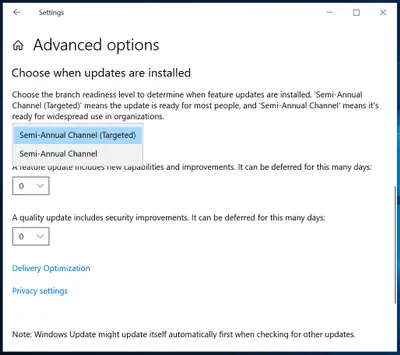Most of us are aware that Microsoft is releasing two Semi-Annual Channel releases each year. This is done so as to simplify and align Windows servicing terminology with Office. The updates are meant only for Windows Update for Business. Meanwhile, Microsoft has been working on Windows 10 release information page.
As of now, Windows 10 release information page lists separate entry for SAC-T information. However, starting now the release information will include a single entry for each new SAC release. Furthermore, the release information also makes it clear that there is only one release date for each SAC.
How will removal of SAC-T be reflected on Windows 10 v1903

It is but natural for Windows Update for Business users to wonder how the release will reflect the removal of SAC-T. Microsoft has deployed some clever mechanisms for the removal of SAC-T and updating process. The tool will let you choose a single deferral value based solely on the SAC release date. In other words, if you are trying to set up validation flights in your environment using Windows Update for Business you need to do it from a common release start date.

That being said this will not change your deferral values and all device deferrals will now be based on the release date. Moreover, you will also be having an option to enroll devices in the Windows Insider Program and also choose a pre-release ring. The image below clearly shows the difference between the previous and the latest setting panel.
Handling transition to Windows 10 v1903 with customers who have branch readiness configured for SAC
Following are the ways in which Microsoft will handle the transition to a single SAC release date.
- Windows Update for Business customers who have configured a deferral based on the SAC-T branch-readiness level (remember, this really is the actual release date), devices will be offered the update once the configured number of deferral days have passed. Thus, no change from previous releases.
- For devices that have been configured with a branch readiness of SAC, for the upgrade to version 1903 only, we will add an additional 60 days to the configured deferral. This will simulate the delay previously experienced when Microsoft declared the SAC milestone. For example, if your device is currently configured to defer updates 30 days from the SAC release date, for the upgrade to version 1903 (and this time only), we would append a 60-day delay to that configured 30-day deferral–meaning that the device would be upgraded 90 days (60+30) after version 1903 is released. (Note that the additional 60 days will be handled on our service side, and will not be reflected in your device configuration.)
- For subsequent feature updates after version 1903, your Windows Update for Business configuration deferral value will be whatever it was before version 1903; we are not modifying that value.
You can read more on microsoft.com.
Leave a Reply